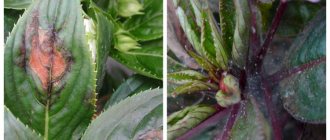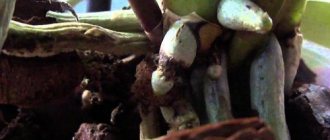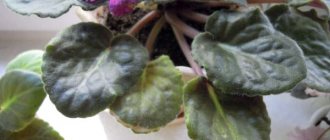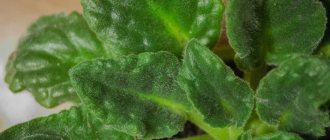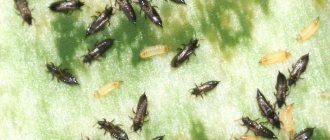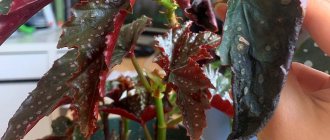Usambara violets, which are loved by many gardeners, along with other indoor plants, are often affected by harmful insects and various diseases, and in some cases suffer from improper care for them.
The delicate stem of Saintpaulia attracts pathogens and pests. To protect these attractive plants from the listed ailments, it is important to know how to properly care for them , to have an idea of the symptoms of damage to them by various pests and diseases. The problem should be recognized as quickly as possible, while the degree of damage to the flower is minimal, in order to immediately begin effective treatment.
Our article is about which diseases and pests of violets are most widespread, and how to fight them.
Diseases of Uzambara violets
The main reasons for the appearance
If you start growing Saintpaulias, then for them to grow well you need to create conditions that are as close as possible to what they had in the natural environment.
Saintpaulias are native to tropical eastern Africa, where the climate is warm and humid all year round.
Such conditions should be created for a flower growing on a windowsill, otherwise violets' immunity decreases and they become susceptible to various diseases.
Temperature factor
Saintpaulias prefer warmth. They need to be kept at a temperature of 20-25 degrees and avoid temperature fluctuations and drafts.
If the flower is in a cold room and watered too often, this will lead to rotting of the stems and roots.
Flowers kept at temperatures above 30 degrees are often affected by fungal and bacterial diseases.
Lighting
Violets grow well in soft, diffused, medium-intensity daylight.
If there is insufficient lighting, Saintpaulia will not bloom. With too much light, the leaves become lethargic, turn yellow and become covered with spots.
Soil composition
The soil in the pot should be moisture- and breathable, balanced in nutrients . In addition, the soil must allow excess moisture to pass through.
On heavy, floating soils, the roots of Saintpaulias rot. Before use, the soil should be frozen for 7 days to prevent infection.
The soil for violets should be very light.
Watering
The soil under the violet should not be wet, but moist . It is unacceptable to use cold water for irrigation To create the required air humidity, the pots are placed in trays with moistened gravel or expanded clay and water is sprayed with a spray bottle.
Soil solution reaction
In acidic soil , when the pH value is less than 5 units, the edges of the leaves become yellow and the rosette becomes thickened. In this case, you need to dissolve 1 spoon of dolomite flour in 5 liters of water and water the Saintpaulia with this solution.
In an alkaline environment, Saintpaulias turn pale and refuse to grow. In this situation, you need to dissolve 1 tablespoon of vinegar in 2.5 liters of water and irrigate the violet with this solution.
What to do, if
Sometimes novice gardeners have questions that can be answered by their more experienced colleagues.
Droplets appeared on the violet
The question is often asked why droplets of liquid formed on the violet; there are 2 possible answers:
- if these are drops of water on the edges of the leaves and they appear in the morning, then high humidity can cause their occurrence (after watering, the plant releases excess liquid that accumulates in the form of drops);
- if the drops look like sugar syrup, then most likely the plant has scale insects.
Violet has lumpy leaves
When beginning violet lovers buy a young plant, they see smooth, even leaves. After some time, you can notice that the leaves have become hard, lumpy, and the rosette has become very thick. This may be due to overexposure when the plant is located near a window and most of the day is well illuminated by the sun. To eliminate this problem, the violet bush needs to be sent to the eastern window or shaded with something.
There are midges
If you notice that midges have appeared above the violets, there may be several reasons:
- excess moisture due to excessive watering;
- high air humidity;
- the use of organic fertilizers such as humus, tea leaves;
- rotting old leaves;
- using garden (unsterilized) soil to prepare soil mixture.
Midge larvae, hatching in the ground, feed on rotting organic particles and damage the roots of the plant, causing considerable harm to it. If a midge appears on violets, how to get rid of it:
- spray the flower with a pink solution of potassium permanganate;
- add wood ash to the ground;
- Dissolve 10 g of soap in 0.5 liters of water, water the soil in the pot.
Photos and descriptions of the most common diseases
The plant itself
The list of possible diseases of indoor Saintpaulias is quite extensive. Most often, violets get sick when, for some reason, they become weakened and lose their immunity.
The main reason for the weakening of Saintpaulias and their damage by diseases and pests is improper care of the flower.
Below we will talk in detail about the diseases of Uzambara violets and their treatment; the photo will also serve as a clear example.
Root rot
If violets are affected by root rot, they refuse to bloom, the lower leaves of the flower become sluggish, and the petioles become soft. The disease is caused by a fungus that quickly develops in waterlogged soil.
The main reasons for the proliferation of the fungus are the following:
- there are no drainage holes in the flower pot;
- too frequent watering;
- the soil is of poor quality;
- cold soil in a pot;
- abundant watering of parched soil.
If all diseases of Saintpaulia violet are taken as 100%, then 75% of them will be root rot. As a preventive measure against these rots, it is recommended to water with small portions of water.
Root rot.
In the case when root rot is diagnosed in a violet, it is necessary to immediately carry out resuscitation actions according to the following scheme:
- remove the flower from the pot;
- inspect the roots and if they are not white, it means they are affected by root rot;
- cut off the lower leaves;
- cut off diseased roots;
- trim the affected part of the stem to a healthy one;
- treat the stem with a fungicide;
- place in a substrate to form new roots;
- put a synthetic bag on top of the flower;
- install the flower in a cool room and under artificial lighting;
- Saintpaulias that have formed new roots are transplanted into pots with soil.
Attention! If not only the roots of a Saintpaulia plant are affected, but also the entire stem, it is impossible to revive such a plant. It should be thrown away.
Gray rot
If a grayish fluffy coating , this means that your flower has been infected by the botrytis fungus. This pathogen is capable of engulfing the entire flower in the shortest possible time and leading to its death.
Gray rot.
Fungal spores are usually localized in the soil and from there they move to the vegetative parts of the plant. In this regard, the soil should be frozen for a whole week before using it as a substrate for violets to destroy fungal spores. After freezing, it’s a good idea to spill the substrate with a solution of potassium permanganate.
Already diseased plants require increased attention. Browned fragments of Saintpaulia must be immediately removed, and then the flower must be treated with a fungicidal agent. Skor and Fundazol are better suited than other fungicides.
To prevent such a disease, it is necessary to avoid overflowing water when watering and avoid temperature changes.
Important! To reduce the risk of Saintpaulia being affected by gray rot in the cold season, reduce air humidity. In addition, the affected parts of the violets should not fall on the soil in the pot.
Powdery mildew
This insidious fungal disease often affects violets. A visual symptom of this disease is a white coating on the leaves and stems of Saintpaulia, similar to flour.
The spread of the fungus occurs through spores that can be found in the soil. More often than others, this disease affects weakened Saintpaulias that have recently been transplanted, old flowers, or those that have recently passed the flowering phase.
Saintpaulias can be affected by two types of powdery mildew: downy mildew and true mildew. Both diseases are very dangerous and harmful to violets.
Real
The disease first appears as a light white coating on the leaves and petioles . Later, ulcers appear on the vegetative parts of Saintpaulia, and the surface of the leaves becomes deformed.
At the final stage of the disease you can observe:
- complete inhibition of plants;
- cessation of growth;
- death of a flower.
The causes of damage to a flower plant are:
- poor plant care;
- excess nitrogen in the soil;
- infection from diseased plants;
- when using contaminated soil;
- when using contaminated tools when caring for and replanting plants.
Powdery mildew.
Reanimation of violets should be started immediately after the first symptoms of the disease are detected.
The algorithm of actions should be as follows:
- inspection of the flower;
- cut off damaged leaves and stems;
- treat the remaining vegetative part of the plant and the soil with one of the following preparations: Fundazol or Topaz;
- After processing, place the flower in a dark and warm place until it dries completely.
As a preventive measure, it is recommended to maintain the recommended balance of potassium, nitrogen and phosphorus in the substrate. For fertilizing, use mineral fertilizers containing a high percentage of phosphorus and potassium.
In the process of transplanting a flower, it is necessary to treat it with one of the following fungicidal agents:
- Infinito;
- Previkur;
- Thanos.
False
The symptoms of this disease have some differences from powdery mildew:
- at the beginning of the disease, a silvery or white coating appears on the underside of the leaf;
- at the second stage of the disease, light green, reddish or brown spots appear on the upper side of the leaf;
- at the third stage, if no treatment is taken, Saintpaulias die.
Downy mildew.
Therapeutic and preventive measures are identical to those used for powdery mildew.
Important! The disease progresses rapidly at high relative humidity.
Late blight
One of the most insidious fungal diseases on plants. A sign of the disease are brown, slowly drying spots on the leaves of the crop.
As late blight develops, the spots increase in size, the tissue in the affected areas dies, and the flower rosette withers. With this disease, watering does not help restore turgor.
Late blight.
If the top of the rosette is not affected by the disease, it is cut off and rooted , having previously been treated with a fungicidal agent. The rest of the violet is thrown away.
All indoor plants standing next to the affected flower are subject to preventive treatment according to the instructions with a fungicidal agent .
Vascular bacteriosis
In the summer, when hot weather sets in, flower growers' violets can suddenly die from bacteriosis. The main symptoms of this disease are:
- the appearance of brown spots on the stems and leaves of the crop;
- first the lower and then the upper leaves change color, acquiring darker tones;
- The leaf tissues become soft and Saintpaulias soon die.
Vascular bacteriosis.
From the moment a flower is infected until it dies, it takes from 3 to 30 days. It is impossible to cure sick Saintpaulias . The disease easily spreads to healthy plants.
As a preventive measure against the disease, it is recommended:
- do not overdry the substrate;
- do not overwater when irrigating;
- in hot weather, shade flowers;
- in the spring, transplant Saintpaulia into a pot with new soil;
- in June, treat Saintpaulia with Epin.
Fusarium
This is one of the most dangerous diseases of violets. At first, it affects the root system of the plant. The roots become soft and begin to rot. Then the infection penetrates through the vessels into the stems, petioles and leaves of Saintpaulia.
Almost all the leaves of the lower tier wither, the stems become watery, and then die completely. Plants that are weakened after flowering or due to a lack of fertilizer in the soil die faster than others.
Fusarium.
Diseased plants should not be left as is. The following measures are required:
- the diseased plant is removed from the windowsill;
- affected flowers are disposed of along with the soil;
- the pot and tray are treated with copper sulfate.
To prevent this disease, it is recommended to adjust the watering regime and water the soil monthly with a solution of phytosporin.
Bronzing and leaf spot viruses
With this disease, the appearance of the leaves changes and plant development is inhibited.
Virus-affected violets refuse to bloom, and in the later stages of the disease they completely stop their development.
The disease is spread by thrips. It is useless to fight this disease; affected plants must be disposed of immediately.
Rust
You can lose your favorite flower due to a fungus that causes a disease such as rust. this disease by the first signs:
- First, small yellow spots appear on the upper surface of the leaf . And on the underside, colonies of the fungus are visible in yellow pustules . When the pustules open, fungal spores fall out of them and spread around the room, infecting healthy plants;
- If warning signs of the disease are detected, you must immediately begin treatment: cut off and dispose of the infected parts of the Saintpaulia;
- remove the diseased flower from healthy plants;
- spray the leaves with a fungicidal agent.
- rust is treated with Baktofit, Topaz, Fitosporin-M. If the disease is advanced, treatment will not help. In this case, the flower is thrown away.
Rust.
Important! Most often, Saintpaulias are affected by rust in winter and spring. Lack of lighting, weak immunity, and the presence of a source of infection in the room are the main causes of infection.
Leaves
If you notice spots of different colors , this does not mean that they are infected.
The reason for their appearance may be the following factors:
- sunburn;
- improper lighting;
- chemical burn;
- excess or lack of fertilizers in the soil;
- other reasons described below.
Saintpaulias grown by beginners often experience changes due to improper care. The following symptoms are noted:
- spots of different colors on the leaves;
- wilting and drying of leaves;
- root rotting.
For what reasons such undesirable changes may occur, read below.
Stains
Most often, such spots are colored brown or yellow. As usual, this occurs due to direct sunlight hitting the flower. In other words, this is a sunburn.
Sunburn.
You can save the violet from the destructive rays by shading it with curtains or by relocating it to the windowsill of a north window.
Saintpaulia leaves can become stained for other reasons:
- the air in the room is too dry or humid;
- violation of the watering regime;
- excess fertilizers have been added, especially nitrogen-containing ones;
- use of cold irrigation water.
Withering and drying
The edges of leaf blades may darken and dry out for four reasons:
- overfilling the soil with water when watering;
- deficiency of certain nutrients in the soil;
- unsuitable soil;
- presence of drafts in the room.
When faced with these symptoms, you need to:
- reduce watering;
- fertilize with fertilizers;
- loosen the soil in the pot;
- avoid drafts.
Roots
The main reasons for the rotting of the underground part of Saintpaulias are excessive watering and the acidic reaction of the soil solution.
To avoid this negative phenomenon you need to:
- water the plants with bottom watering;
- use pots with holes in the bottom;
Pots must have drainage holes.
- place pots in a tray;
- pour water only into the pan and keep the water level for half an hour;
- Then you need to drain the water from the pan.
In order not to make a mistake with acidity, you need to use purchased soil for violets.
Many Saintpaulia diseases occur due to improper care. Under optimal conditions, violet blooms for 6 months or more:
- flowers prefer to grow on eastern windows, where in winter artificial lighting is used for 10 hours a day;
- air humidity should be kept in the range of 65-75%, and its temperature should be from 18 to 24 degrees above zero;
- Pots for Saintpaulia are selected with a diameter of 6-7 cm, and the soil in them is light and quite nutritious.
When spots appear on leaves
Spots on violets primarily affect the leaf blade, since it is all covered with delicate fluff. The villi react to external influences, signaling a change in color, first in small areas of the leaves, and then throughout the entire plant.
The primary reason for the appearance of stains on Saintpaulia is external factors. It is enough to change the position of the pot and place it on a more illuminated windowsill, and burns will begin to appear on the flower. And from a draft, a light rim appears, moving over time to the central part of the plate.
Internal diseases of the plant are no less common, one of the symptoms of which is spots. Leaf disease occurs when there is an excess of moisture or severe drying out of the soil. It can develop from a lack of essential vitamins if the wrong fertilizer is used.
The most dangerous cause is considered to be fungal infection due to improper maintenance or transfer from a diseased specimen. It is quite difficult to detect mycosis in the early stages, since the first symptoms appear from the bottom of the lower leaves. In more visible areas of the plant they can be seen in more complex forms.
Another reason why Saintpaulias become spotted may lie in the colony of insects. It’s easy to diagnose unwanted residents - look at the mites themselves or their ovipositors through a magnifying glass. In this case, a characteristic difference from other diseases is the presence of holes in the spot area.
Insect pests
The delicate vegetative parts of Saintpaulia and the roots of the plant are of interest to a large number of pests. Any type of harmful insect can cause significant harm to an indoor flower.
In addition to the fact that they themselves drink the juice of the plant or gnaw the leaves, the pests on their paws carry the causative agents of insidious diseases of violets.
To prevent pests from harming violets, you should regularly inspect the leaves, petioles and buds. This is especially true in the summer, when the windows are opened for ventilation.
It is also important to carefully inspect pots and plants at the time of purchase , as well as when you bring cut flowers into the house. In addition, pests can enter your home through soil and airborne means , often with the help of insects.
The most common pests of violets are:
- aphids;
- scale insects;
- mites;
- thrips;
- nematodes;
- Mealybugs.
Important! You must be able to visually recognize Saintpaulia pests and know measures to combat them.
Mealybugs
When infested with mealybugs, white flakes . Whitish lumps are found in the soil of infected plants . It is there that scale insects accumulate and feed on plant juices.
Mealybug infestation.
Adult insects range in size from 3 to 6 mm. Flowers are damaged not only by adult scale insects, but also by their larvae . The violets on which they parasitize are stunted, their leaves become dull and wither.
If proper measures are not taken, healthy plants will also become infected. Ultimately, the scale insects will lead to the death of the plant.
Treatment of affected violets is carried out:
- spraying violets three times at weekly intervals with a solution of green soap (10 g of crushed soap per 1 liter of water);
- spraying according to the instructions with a solution of Mospilan or Regent.
Aphids
This insect is easy to see on violets with the naked eye. Aphids create their colonies on the undersides of leaves or in buds. In their habitat, sticky secretions are found.
Insects and their older larvae suck plant sap, and over time a fungus settles on the sticky secretions. In addition, aphids carry viruses.
Aphid.
Symptoms of the lesion are as follows:
- deformation of the flower apex;
- ugliness of flowers;
- poor bud development;
- leaf curl.
Fighting aphids is not very difficult, especially at the first signs of damage. You can try washing it off with soapy water.
If the soap does not give the desired effect, then you should use one of the purchased insecticides:
- Fitoverm;
- Aktellik;
- Intavir.
Shields
This is another insidious pest that parasitizes Saintpaulias. It is difficult to combat scale insects and false scale insects due to their high fertility. Numerous larvae emerging from the eggs consume plant sap for nutrition, greatly weakening the violet.
Brownish-red scutes appear on the underside of the leaves, and yellow spots from insect pricks appear on the upper side of the leaf. In addition, adult scale insects secrete a sticky mass on which sooty fungus settles.
The body of adult scale insects is covered with a dense shell, so it is impossible to exterminate them with insecticides. They should be collected from violets by hand. You can try treating the leaves and stems with soapy water and adding a little kerosene to it. Treat the vegetative part of the plant with this solution.
Scale insects.
Ticks
Ticks on home Saintpaulias are quite dangerous pests. Ticks eat violet juice by making punctures in the young leaves of the plant. Adult insects are so small that they are difficult to see with the naked eye. There are several types of harmful mites :
- arachnoid;
- cyclamen;
- flatfish.
When you detect the first signs of the presence of ticks, you can first try to get rid of them using folk remedies:
- moisten a piece of cotton wool with vodka and wipe the leaves and petioles with it;
- after three days, spray the violets with an infusion of onion peels (80 g of onion peels, pour 3 liters of boiling water, leave for 48 hours).
If the smell of alcohol and onions does not repel pests, then you can resort to “heavy artillery” - the use of chemicals. Special preparations have been created against ticks - acaricides. The most popular are:
- Apollo. This is a contact-intestinal drug. From its influence: the eggs of the pest die;
- Tick larvae are destroyed;
- adult ticks lose their ability to reproduce.
- Neoron. The newly created remedy begins to act from the inside, once it reaches the intestinal tract of the tick. The action lasts from 10 to 40 days. As a result, the insects die;
- Fitoverm. A very popular insecticidal and acaricidal agent with enteric contact action. One spray treatment of Saintpaulias protects them from ticks for 20 days.
Arachnoid
This type of mite can also be found on violets. It affects petioles and leaves. At the point where the petiole attaches to the stem, the mite leaves a thin white cobweb.
Spider mite infestation.
Due to the loss of cell sap, the flower loses its decorative qualities. The leaves of the affected flower become deformed and turn brown. At the next stage, the leaves dry out and fall off.
Cyclamen
The main symptoms of cyclamen mite infestation are:
- growth inhibition;
- cessation of flowering;
- leaf compaction;
- There are small yellow spots on the leaves.
Cyclamen mite.
Important! Typically, cyclomene mites are localized at the top of the rosette.
Flat beetle
This pest is a rare guest on violets . If Saintpaulias are affected by this type of mite, their leaves curl inward, which over time lose turgor, dry out and fall off. A violet left without leaves can die.
Thrips
Thrips are dynamic insects and this makes them very dangerous for violets. They quickly move from affected plants to healthy specimens, and on their legs they can carry pathogens of various diseases. Insects multiply quickly, feeding on the juice of Saintpaulia.
Signs of the presence of this insect on Saintpaulias are scatterings of pollen and paths on yellow leaves.
Thrips.
There are many ways to combat thrips , but we will describe only a few of them. You can try the following recipe:
- take 25 ml of flea shampoo;
- dilute shampoo in 5 liters of water;
- add 1 ampoule of Fitoverm to the composition;
- mix the composition.
Next, you need to wrap the pot with violet in cellophane so that the soil does not fall out. Then place the vegetative part in the prepared solution for 15 seconds. After completing the procedure, you should spill the soil in the pot with Aktara solution, prepared according to the instructions.
Important! During the growing process, the flower stalks of Saintpaulias should be cut off in a timely manner in order to deprive the pest of its main food - pollen.
Sciarides
Sciarides are represented by small black flies and are known to many gardeners. Their harm lies in the fact that they feed on plant juices, and their larvae infect the root part of Saintpaulia.
Sciarida (fungus gnat).
To exterminate them, you need to spill the substrate in the pot with one of the systemic insecticides . For preventive purposes, you need to improve the care of flowers, especially pay attention to watering. Excess moisture promotes the proliferation of these insects.
Nematodes
This is one of the most insidious and harmful enemies of violets , which is not easy to exterminate.
Infection occurs through components of the soil composition. From there, these roundworms bite into the roots of violets, clog the vessels of plants, feed on the sap, disrupting the supply of tissues with necessary substances. In addition, nematodes poison violets with their metabolic products.
Symptoms of nematode damage are as follows:
- plants are weakened, grow poorly and do not bloom;
- the stems and roots of violets thicken;
- the leaves become smaller, their shape changes;
- babies are being formed en masse.
Nematodes in the roots.
It is impossible to get rid of the nematode; the affected plants are thrown away along with the soil. The pot and tray must be disinfected.
As a preventive measure, we can recommend:
- pieces of peat and dry marigold petals should be added to the soil;
- regularly water the violets with marigold infusion;
- Use new pots for replanting.
general information
Violets react sharply to mistakes in care. If you do not maintain an optimal microclimate for plants and do not take enough care of them, they will respond to this with a deterioration in appearance and well-being, and the appearance of spots on the foliage.
If you notice an alarming sign, urgently find out the cause of the stains, then begin to eliminate this very cause. Ideally, of course, it is better to prevent a problem than to treat it later. Indeed, in severe cases, the violet may even die.
Fortunately, more often the spots signal minor problems - sunburn, water getting on the leaves and in the outlet. Dealing with these problems is not difficult. The most important thing is to understand exactly why the spots appeared and continue to maintain and care for the flower correctly.
To carefully examine the spots, you will have to arm yourself with a magnifying glass or magnifying glass. It is important to understand the etymology of neoplasms - this determines what measures will be taken in the future. For example, small dark dots most likely indicate a fungal infection, and holes indicate the leaves are being devoured by insects. Next, we will consider in more detail all the possible causes of stains.
Prevention and enhancement of plant immunity
You can reduce the risk of disease in Uzambara violets and protect flowers from damage by harmful insects if you adhere to certain rules and take preventive measures.
Experienced flower growers claim that most often infection occurs when purchasing new rosettes in a store. New plants purchased externally cannot be immediately placed next to other domestic flowers. You need to quarantine for a month .
During this period, when Saintpaulia is undergoing acclimatization, you need to carefully monitor it. If you bought a violet in bloom, then its flower stalks must be removed immediately . Thus, the risk of infection with thrips is reduced.
Before planting, it is necessary to disinfect the soil and pots. They may have an infection.
From the first days, Saintpaulias must be provided with optimal conditions of detention. This means proper lighting, watering and timely application of fertilizers.
After the flowering phase, violets are always in a weakened state. During this period, it is necessary to feed it with fertilizers.
Proper care
Diseases of home violets and treatment for them always require a lot of energy from the gardener, so in order to avoid them it is necessary to organize proper care for the flower:
- choose a growing container of the right size;
- make the soil correctly or buy it in a store;
- select the required lighting;
- the temperature must be in the correct range;
- properly organize the watering regime.
It should be remembered that properly organized care will eliminate the appearance of purpuric disease.
Read more about organizing proper care for violets in this article.
Sunburn
If this is the reason, the spots will be brown. They appear if the plant has been exposed to direct sunlight for a long time. The spots in this case have a pronounced brownish tint and a regular round shape. Over time, a through hole may appear in the middle of such a spot.
It is quite simple to understand that these spots are caused by the sun. If alarming symptoms appear on those leaves that are turned towards the window, there can be no doubt.
What to do
Unfortunately, you will have to part with the already affected parts of the flower, as they are weakened and can become infected. Move the pot with the plant away from direct sunlight. Place the violet on the windowsill in the northern or northwestern part of the house. If the windows are only from the south, provide shading during the midday.
Aphid
Aphids may appear on the back of young leaves of indoor violets. She can fly to you from the neighboring balcony through the window, or you yourself can bring her into the apartment with flowers bought in a store or cut at the dacha. In addition to Saintpaulia leaves, it affects peduncles, buds and flowers. These small green (gray or black) insects feed on the sap of the plant. As a result, the growth of the flower slows down, the leaves fade, and the flower petals become deformed and dry out. When the aphid colony is numerous, it forms a white layer of sticky liquid on the surface of the leaves.
To fight aphids on violets, purchase one of the insecticides in the store: Fitoverm, Actellik, Mospilan, Actofit. Carry out the treatment strictly according to the instructions and in the quantity indicated on the packaging. Once is usually not enough to get rid of prolific insects.
Bacterial infections
If Saintpaulia is affected by a bacterial infection, the spots will appear with an oily texture - yellowish, light or white. There will be no mold on their surface. Also, if the leaves have a bacterial infection rather than a fungal infection, you will not find pustules from the spores. Also, bacterial diseases are characterized by a light green border on the foliage. Note that bacteria are much more dangerous than fungus and often lead to the death of the entire plant.
It should be borne in mind that some hybrid varieties of Saintpaulia have a particularly delicate constitution and are more often susceptible to bacterial infections than others.
Bacterial burn occurs due to systematic waterlogging of violets. Often in the summer heat, new flower growers try to water their violets harder, thinking that they do not have enough moisture. However, such waterlogging becomes the cause of the disease. If a burn occurs, the foliage will become covered with black spots, and the stem and petioles will also darken.
What to do
If the lesion has not yet spread, the following drugs can help: HOM, Kuproxat and other copper-containing ones. We recommend using systemic rather than contact fungicides. If the latter destroy the infection only through direct contact, then the former are able to penetrate the tissue and protect the entire plant.
Important: use preparations carefully - some of them can significantly and permanently spoil the appearance of Saintpaulia. For example, the drug Maxim leaves red spots on the leaves, and Bordeaux mixture leaves white spots.
In order to prevent bacterial diseases, proper agricultural practices must be followed when growing violets. In addition, regular use of special biostimulant drugs can help. These remedies do not cure, but increase the immunity of plants, promote their rapid growth, good flowering, and strengthen them. We recommend the following drugs in this spectrum:
- Epin;
- Humate;
- Zircon;
- Agate.
Drafts
If the leaves of Saintpaulia become spotted due to drafts, the spots will be whitish. These plants are very sensitive and suffer from cold gusts of wind and get sick.
By exposing flowers to cold, even briefly during the ventilation period, you can end up with a diseased plant covered with unsightly spots. Note that the shape of the spots in this case will not only be round, but also very different, sometimes very bizarre.
What to do
When ventilating the room, make sure that cold air flows cannot reach the violet. If this cannot be ensured, it is better to take the violet to another room while this one is ventilated. Those leaves that are already affected will have to be removed. But, having recovered, the flower will quickly grow new green mass - you can help it with this with nitrogen fertilizing.
Sciarides
In an over-moistened and rotted substrate, flies and mosquitoes - sciarids - can appear. Adults are almost safe for violets, but their larvae quickly destroy and compact the substrate, reduce the access of oxygen to the roots, which causes enormous harm to the violet’s root system. However, if there are a huge number of midges, they begin to eat the leaves and stems of homemade violets. Sciarides pose a particular danger to young, not yet mature violets. Their vital activity leads to rotting of the stem and root system of the flower.
To get rid of them, you need to treat the soil with a solution of Aktara or Karbofos (water it). Additionally, you can coat the edges of the pot with chalk to prevent cockroaches. Adults are destroyed by any aerosols such as “Dichlorvos” or “Raid”. If the substrate is heavily infested with midges, it should be replaced completely. New primer should be calcined for 30 minutes in the oven to guarantee. The pot should also be disinfected. In the future, avoid waterlogging the soil.
Thrips
Thrips on violets also like to feed on sap. These are small flying “insects” of a dark brown color. They have a wide range of attacks on indoor plants, including eating foliage. Thrips carry causative agents of various violet diseases from outlet to outlet, so they are very dangerous for indoor crowded plantings. You will see their presence by white stripes, brown or black spots on gnawed leaves and flowers. You can try to collect thrips by hand, but it is better to treat the flower with preparations such as Fitoverm, Actellik or Aktara. It is necessary to process not only the violet leaves, but also the substrate. Pick off flower stalks - Saintpaulia pollen is a favorite food of thrips.
This may be interesting: Clerodendrum - home care
